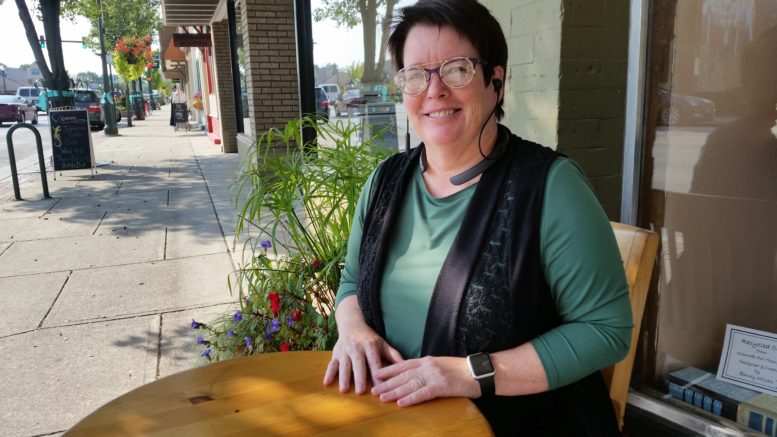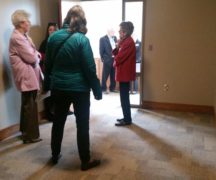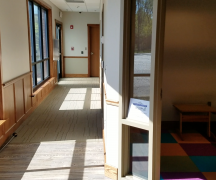By JAN LARSON McLAUGHLIN
BG Independent News
Michelle Clossick has spent the last decade giving domestic violence survivors in Wood County a safe place to stay, a voice in the legal system, and hope that life can be better.
Clossick, the founding executive director of the Cocoon domestic violence shelter in Bowling Green, came to the position as a survivor herself. She was sexually abused by her grandfather for much of her childhood, then was sexually assaulted twice as a young adult.
“For some reason, I was able to survive in a way that I got myself through college and kept coming back to this line of work,” Clossick said. “It’s like a responsibility. It’s important to use my strength to help other people.”
Now Clossick is facing a different type of challenge. In early April, she had just driven 3,000 miles for college visits with her son, when two blocks from her home a car pulled out in front of her. She was left with a traumatic brain injury that has grossly affected her life. She still goes to physical therapy multiple times a week, and wears multi-lens glasses that have to be frequently modified.
“It’s like being seasick all the time,” Clossick said. “It’s the hardest thing having a brain injury because it doesn’t look like there’s anything wrong.”
The lasting effects from the accident have led Clossick to leave her leadership role with the Cocoon.
“I didn’t feel done in any way with the Cocoon,” she said. But the agency is in the middle of a capital campaign and a transition from its first shelter at an apartment complex in Bowling Green, to the former Elk’s Club building which has been completely renovated as a domestic violence shelter.
“I’m not able to do that right now,” she said of demands on the executive director. “But my intention is to continue to support the Cocoon in the ways I can.”
“I believe in the Cocoon and the difference it’s made in the community,” she said.
Clossick, who had been executive director of a sexual assault and domestic violence crisis center in Pennsylvania, came to Ohio in 1997 when her partner took a job at Bowling Green State University.
“I agreed to come to the flattest place on earth,” she said with a smile.
She started doing private practice work, but realized something was missing.
“I always feel pulled – that socially there are things that need to change,” she said.
Clossick was hired by the BGSU Women’s Center to do a research project called “Peace Begins at Home.” The study identified the unanswered need for a shelter in Wood County. Though county government was known for its teamwork approach, that group effort was missing in this case.
“When it came to domestic violence, that isn’t how it was,” she said. “The people who were paying the cost of that were the survivors.”
The issue became more of a priority when a series of domestic violence cases occurred. For a period starting in 2002, domestic violence was the top cause of murders in Wood County. In many cases, children were present and witnessed the murders.
“It was so horrible for communities and the families and the children growing up without mothers,” Clossick said. “It destroys lives.”
That seemed to be the turning point.
“There was pressure to get the Cocoon open before there was another homicide,” she said.
The late Doug Valentine donated the use of an apartment building in Bowling Green for a shelter. And the Cocoon was in business.
Though Clossick was always the face of the Cocoon, she stressed that the community supported the effort every step of the way. “There isn’t a single thing that ever happened with the Cocoon that didn’t take a village.”
But the apartment building had its limitations. It was not built with security in mind, and offered the families housed there little interaction with each other.

The new Cocoon site in the former Elks Club in Bowling Green.
So earlier this year, the Cocoon moved into its new location, which can handle more families, offer more security, and provide more support. “Everything in that space is intentional to support healing, to support successful transitions.” That includes community spaces in the building where survivors can meet together, which is part of the healing process, she said. “You realize you’re not alone in this.”
Reaching out for help is difficult, even frightening for victims of domestic violence, Clossick said.
“For anyone who has ever lived through crisis in their lives, it becomes evident how much trust it takes to ask for help. The courage and the trust – there’s a humility in that. There’s a gift in that, that I will always carry with me.”
Most of all, the Cocoon gives survivors back their voices.
As a survivor herself, Clossick knows the value of that. “I have a deep belief in how important it is to get your voice,” she said. “Things didn’t change for me until I got my voice.”
That voice changed the lives of so many in Wood County, according to Dr. Laura Landry Meyer, one of the Cocoon’s founding board members.
“We wouldn’t exist without her,” Landry Meyer said. “We would still be the only county in Ohio without a domestic violence shelter if it weren’t for her.”
Clossick’s passion and commitment gave families the strength to go on. “She firmly believes in empowerment,” Landry Meyer said.
Though it was a community effort, it was Clossick who led the charge, said Paul Haas, who served on the board for six years.
“No person does anything by themselves. But Michelle has been the glue that has moved the Cocoon to where we have a much better facility,” Haas said. The agency went from being “the best kept secret,” to being recognized for his quality and service.
“She grew the Cocoon, she’s been synonymous with the Cocoon,” he said. “She’ll be sorely missed by the Cocoon.”
According to current board president Travis Lattimore, Clossick worked tirelessly to help the agency expand into the new shelter. “She’s largely responsible for that dream coming true.”
Many of the survivors who were aided by the Cocoon are now coming back to help with the program, Lattimore said. That is a testimony to Clossick’s dedication.
Kathy Mull has been appointed interim executive director. And Clossick is confident the Cocoon will continue to thrive, even without her.
Clossick compared her departure from the Cocoon as a parent launching a child into adulthood. She does not intend to loom and insert herself. “I don’t want to be that person with the Cocoon.”
She does, however, want to continue making a difference. “I want to be engaged with the community to do anti-violence work. Our world needs a cultural shift right now and I want to be a part of it.”




